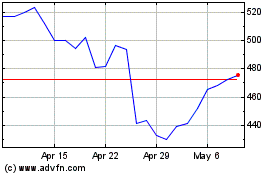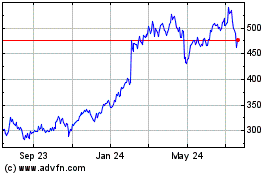By Emily Glazer and Patience Haggin
Around 3 a.m. on a recent Tuesday, campaign staffers for several
Democratic presidential candidates powered up their computers in an
effort to beat out rivals and book crucial ad space for the weeks
before the Iowa caucuses and the New Hampshire primary.
The reason for the early-morning rush: A new tool from YouTube
had just gone live. For the first time it gave political buyers and
others an automated way to reserve ad slots on the popular video
platform, and many rushed to lock in time as far ahead as the end
of February.
"People acted quickly with what was available," said a staffer
for one of the Democratic front-runners, who added that the
campaign snatched up slots in early voting states such as Iowa and
South Carolina.
Already a big destination for digital ads, YouTube -- a unit of
Alphabet Inc.'s Google -- is stepping up its efforts to snag more
political-ad dollars away from local television and Facebook Inc.
The YouTube initiatives aim to take advantage of the growing sums
being spent on advertising by a historically large field of
presidential candidates.
YouTube's new Instant Reserve tool borrows a tactic from the
traditional TV business, where advertisers can often book ad time
months in advance to lock in slots in the best programming at
discounted rates. Before the tool was launched on Sept. 3,
campaigns had to coordinate with salespeople to book ad slots, a
more cumbersome process.
YouTube is expected to take in about $11.38 billion in global ad
revenue this year, according to a forecast by research firm
eMarketer, a 20% increase from a year earlier. Google doesn't say
how much YouTube contributes to its total ad revenue, which was
$116.3 billion last year.
A Google spokeswoman said the company is currently testing the
tool with political advertisers as well as hundreds of others,
including media and consumer-goods companies. Political ads are
subject to additional scrutiny, from verifying the buyer's identity
to embedding a disclosure in the spot stating who paid for the ad,
the spokeswoman said.
Local TV ads have long been an important way to reach voters in
crucial states -- and still are. Political TV ad spending is
expected to reach $4.78 billion in 2020, compared with $2.85
billion for online and digital political ads, according to recent
forecasts from Borrell Associates Inc., a marketing research
firm.
YouTube allows far more targeted advertising than traditional
TV. A YouTube ad can, for instance, be made to appear exclusively
ahead of videos viewed by people identified as left-leaning voters
in Polk County, Iowa, days before the Feb. 3 caucuses, media buyers
said.
At the same time, YouTube's history of controversies in which
advertisements run alongside violent or otherwise objectionable
content has been a concern for political-ad buyers.
President Trump and the nearly 20 Democrats running for
president have so far spent $21.8 million on Google and $43.5
million on Facebook, according to the most recent data analyzed by
Acronym, a progressive nonprofit that tracks digital spending.
Presidential hopefuls' campaigns have been pouring dollars into
Facebook ads designed to spur viewers to donate or join campaigns'
email lists. As the actual voting gets nearer, campaigns tend to
shift their advertising to video spots, which are seen as a better
tool to persuade voters and get out the vote, media buyers
said.
Google has been eager to show political advertisers it can
target audiences more effectively on YouTube than TV can. During
the 2018 election season, it hired Democrat and Republican digital
consultants and pollsters to analyze YouTube's targeting of
specific demographic segments or affinity groups, a person familiar
with the efforts said.
YouTube shared that research and targeting with big buyers weeks
before the 2018 midterms to show how granular the information could
be. For instance, documents reviewed by The Wall Street Journal
described several groups of people that the research had identified
as persuadable voters, including "bargain hunters" and "30-minute
chefs."
In December, after the election, YouTube convened around 200
Democratic and Republican political consultants in Washington to
tout its effectiveness further, including citing its work promoting
the movie "The Greatest Showman."
The message was, "spend as much money with us as possible and
it'll go far," one attendee said.
Mr. Trump and Democratic presidential hopefuls including
California Sen. Kamala Harris, Massachusetts Sen. Elizabeth Warren,
Vermont Sen. Bernie Sanders and South Bend, Ind., Mayor Pete
Buttigieg purchased YouTube ads after the new tool made its debut
last month, according to digital ad research firm Pathmatics.
The 2020 election season officially kicks off in February, with
contests in Iowa, New Hampshire, Nevada and South Carolina. No
presidential candidate since Bill Clinton in 1992 has managed to
clinch the nomination without having won at least one of the first
four states that election cycle.
On Nov. 15, Google plans to let ad buyers reserve slots on
YouTube for the entirety of 2020, a presidential campaign digital
buyer said.
They also can buy ads live using YouTube's auction mechanism,
but that often proves more costly. On top of automating the
process, the new system removes the minimum amount of spending
YouTube used to require for reservations.
Users of YouTube's new tool can reserve slots but won't have to
pay until the ads actually appear, media buyers said.
The company warned users not to see this as a license to
overbook.
"If we see advertisers abusing the system, we reserve the right
to strip external reservation privileges for the remainder of the
2020 cycle," according to an email Google sent to ad buyers in
recent weeks that was reviewed by the Journal.
Write to Emily Glazer at emily.glazer@wsj.com and Patience
Haggin at patience.haggin@wsj.com
(END) Dow Jones Newswires
October 08, 2019 05:44 ET (09:44 GMT)
Copyright (c) 2019 Dow Jones & Company, Inc.
Meta Platforms (NASDAQ:META)
Historical Stock Chart
From Mar 2024 to Apr 2024

Meta Platforms (NASDAQ:META)
Historical Stock Chart
From Apr 2023 to Apr 2024
